The Zohar as a Resource and Model - (4)
"God desired... to make Torah great and glorious." (Isaiah 42:21)
Part of what makes Torah -- the whole sum of Jewish teachings and traditions -- great and glorious is that it becomes more varied and rich with the contributions of each one of us. All of us are involved in making the Torah greater, enlarging and shaping the Judaism of today and the future. Not that any of us can decide what we want Judaism to look like, and then make it so; time and the whole Jewish people will decide. But in many ways -- how we practice Judaism, how we think, how we teach children, how we do creative work with Jewish content, how we live as Jews -- we are creating the possibilities that the Judaism of our time and the future will emerge from. We may choose to be involved in this process with more or less awareness or deliberateness, but we are all involved in it.
The authors of the Zohar took a deliberate and conscious role in shaping Torah for their time and the future. In a number of ways, their work can be a resource and model to us in making our contribution to Torah -- first of all, as a model of the holy chutzpah, the holy boldness, to realize that we also have Torah to contribute. They presented their work as a holy book -- as Torah -- and the generations after them accepted it.
They were fearless in their quest for reality. We have mentioned their use of Christian ideas, something that is still frightening to many Jews today; their confrontation with the reality of evil; their willingness to see God as many as well as one. Whether or not we agree with their view, their fearlessness in facing reality and expressing what they saw is a model for us.
The flip side of this boldness is that the authors of the Zohar were not starting from scratch. They were truly immersed in Torah study. They lived in the verses of the Bible, in the stories of the Midrash. Their dreams, their free associations, were woven out of the Torah they learned. Our contributions to Torah, too, will usually be richer and truer if we are immersed in the Torah of those who have gone before.
At the same time, what the authors of the Zohar created was far from being a copy or repetition of what had gone before. Something new was created by their encounter with Torah, because they brought to Torah all of themselves. They met Torah with everything they had learned, from within and outside of Judaism, and with the wholeness of their own selves, including their physicality and sexuality, and their own experience of life. They show a way to know God through knowing your self, your friends, your life however it looks and however it feels. They did not submit themselves to Torah, and they did not make Torah submit to them; there was a meeting between Torah and their whole selves, and from that meeting came something new, challenging, and nourishing.
HOW TO STUDY ZOHAR
It can be frustrating to read a selection from the Zohar; it is likely to seem obscure in so many ways that understanding it intellectually or emotionally or any way at all seems remote and not worth bothering. If you persevere, however, the riches of the Zohar will begin to open up to you.
Every passage of the Zohar incorporates and interprets verses from the Bible. The interpretations usually have little to do with the literal meaning of the verse -- although looking up a verse will often show that its context is relevant to what the Zohar does with it.
The Biblical verses are interpreted in an imaginative way, based on verbal and imagistic associations. In doing this kind of interpretation the Zohar is building on earlier Jewish texts, found in the Talmud and in books of Midrash. Very often much of the Zohar's interpretation of a verse is taken directly, or with slight changes, from these earlier sources; I have sometimes, though not always, indicated this in the commentary.
The Zohar sometimes refers to other interpretations, using expressions which I have translated as "this has been established" or "the friends" -- that is, the fellowship of scholars -- "have established..." or "we have provided a foundation for the words". Sometimes these expressions are a way of acknowledging that there is a well-known non-mystical interpretation, before presenting a mystical one. At other times they are to alert us that the Zohar itself touches on the same theme elsewhere. Often, they are a way of saying that something bold and controversial is really nothing new; in such cases there sometimes really is an earlier source, and sometimes the Zohar just wants us to think there is.
To the tradition of Midrash the Zohar brings its own flowing, dreamlike approach to imagery, its taste for mythological drama and radical ideas, and the theology of the Sefirot. Arthur Green points out that the varied images of earlier Midrash become, in Kabbalah, "symbol clusters" associated with each of the Sefirot. Thus part of understanding a Zohar passage is the task of connecting each of the symbols to the appropriate cluster, to the Sefirah that it represents -- and letting your understanding of that Sefirah grow with each new symbol.
As you look at the selections from the Zohar in this course or in other books, or, ultimately, when you begin studying the Zohar in the original, I suggest the following approach, whether you are studying alone or with others:
Before consulting any commentary, read the passage from the Zohar as you might read a poem, rereading it several times and trying to understand it in an intuitive kind of way.
You might want to follow these steps:
First read the passage all the way through, not trying at all to understand it, but being alert to any feelings or associations that any words or images in the passage evoke for you.
Read it again more slowly, trying to understand it on the simplest literal level -- the simple meanings of the words, how the sentences hang together. This is a good time to look up the verses from the Bible which it quotes, and read a little of their context.
Pause for a while to reflect on the images, ideas and feelings the passage evokes for you.
Read it again, this time connecting the literal meanings with the feelings and images they evoke. Remember that just about anything in the Zohar is an image of God. (If you're uncomfortable thinking about "God", substitute "reality" or "your self".) On this reading, try to understand the text in as much detail and depth as you can. If you know some Kabbalah, decoding which Sefirot and intersefirotic processes the text is referring to is part of this process of understanding -- but only part.
Remember that you may not agree with the text, and that it may give you ideas that go beyond what it originally meant.
Finally, look at a commentary (such as the comments in this course, or in books on the reading list) to see what the commentator thinks about how the text relates to Kabbalistic concepts, to earlier sources, or to other passages in the Zohar. Don't be intimidated by the commentary; if you had a different idea, you may well be right! But do be open to any new insights.
Last of all, before you go on to another passage, reflect on what this passage of the Zohar means to you, and what (if anything) you can do with it in your own spiritual practice, thinking, creating, work. You might even want to offer a prayer of thanks.
AND SO...
Here is a selection of my favourite texts from the Zohar. Most of them are not found in the anthologies of selections from the Zohar which I have recommended for further reading.
I have followed the text of the Zohar in the Ashlag edition (HaSulam), which often mentions small variations in the text found in different manuscripts and editions, and also consulted the text in the edition with Rabbi Moshe Cordovero's commentary. Since there is no standardized text of the Zohar I have sometimes chosen a variant reading that struck me as making the most sense in context.
In the translations, "YHWH" stands for the name of God, written with the Hebrew letters Yud Hei Vav Hei but pronounced "Adonai" or "HaShem" (The Name). "The Blessed Holiness" is the translation of Aramaic Kudsha Brikh Hu or Hebrew HaKadosh Barukh Hu, the most common Rabbinic way of referring to God. It is often translated, "the Holy One, blessed be He", but I am following a scholarly view that Kudsha here means "the Holiness". Still, the Zohar imagines "the Blessed Holiness" as masculine, most of the time.
For each text there is an introduction, a commentary afterwards, or both, to help with part -- but only part -- of the work of understanding. Clicking on some key words will tell you instantly which Sefirah they most likely refer to, by linking you to that Sefirah in the chart above. After each text there are examples of possible questions for further study and discussion.
Welcome, enjoy,
and keep your seatbelts fastened!
The authors of the Zohar took a deliberate and conscious role in shaping Torah for their time and the future. In a number of ways, their work can be a resource and model to us in making our contribution to Torah -- first of all, as a model of the holy chutzpah, the holy boldness, to realize that we also have Torah to contribute. They presented their work as a holy book -- as Torah -- and the generations after them accepted it.
They were fearless in their quest for reality. We have mentioned their use of Christian ideas, something that is still frightening to many Jews today; their confrontation with the reality of evil; their willingness to see God as many as well as one. Whether or not we agree with their view, their fearlessness in facing reality and expressing what they saw is a model for us.
The flip side of this boldness is that the authors of the Zohar were not starting from scratch. They were truly immersed in Torah study. They lived in the verses of the Bible, in the stories of the Midrash. Their dreams, their free associations, were woven out of the Torah they learned. Our contributions to Torah, too, will usually be richer and truer if we are immersed in the Torah of those who have gone before.
At the same time, what the authors of the Zohar created was far from being a copy or repetition of what had gone before. Something new was created by their encounter with Torah, because they brought to Torah all of themselves. They met Torah with everything they had learned, from within and outside of Judaism, and with the wholeness of their own selves, including their physicality and sexuality, and their own experience of life. They show a way to know God through knowing your self, your friends, your life however it looks and however it feels. They did not submit themselves to Torah, and they did not make Torah submit to them; there was a meeting between Torah and their whole selves, and from that meeting came something new, challenging, and nourishing.
HOW TO STUDY ZOHAR
It can be frustrating to read a selection from the Zohar; it is likely to seem obscure in so many ways that understanding it intellectually or emotionally or any way at all seems remote and not worth bothering. If you persevere, however, the riches of the Zohar will begin to open up to you.
Every passage of the Zohar incorporates and interprets verses from the Bible. The interpretations usually have little to do with the literal meaning of the verse -- although looking up a verse will often show that its context is relevant to what the Zohar does with it.
The Biblical verses are interpreted in an imaginative way, based on verbal and imagistic associations. In doing this kind of interpretation the Zohar is building on earlier Jewish texts, found in the Talmud and in books of Midrash. Very often much of the Zohar's interpretation of a verse is taken directly, or with slight changes, from these earlier sources; I have sometimes, though not always, indicated this in the commentary.
The Zohar sometimes refers to other interpretations, using expressions which I have translated as "this has been established" or "the friends" -- that is, the fellowship of scholars -- "have established..." or "we have provided a foundation for the words". Sometimes these expressions are a way of acknowledging that there is a well-known non-mystical interpretation, before presenting a mystical one. At other times they are to alert us that the Zohar itself touches on the same theme elsewhere. Often, they are a way of saying that something bold and controversial is really nothing new; in such cases there sometimes really is an earlier source, and sometimes the Zohar just wants us to think there is.
To the tradition of Midrash the Zohar brings its own flowing, dreamlike approach to imagery, its taste for mythological drama and radical ideas, and the theology of the Sefirot. Arthur Green points out that the varied images of earlier Midrash become, in Kabbalah, "symbol clusters" associated with each of the Sefirot. Thus part of understanding a Zohar passage is the task of connecting each of the symbols to the appropriate cluster, to the Sefirah that it represents -- and letting your understanding of that Sefirah grow with each new symbol.
As you look at the selections from the Zohar in this course or in other books, or, ultimately, when you begin studying the Zohar in the original, I suggest the following approach, whether you are studying alone or with others:
Before consulting any commentary, read the passage from the Zohar as you might read a poem, rereading it several times and trying to understand it in an intuitive kind of way.
You might want to follow these steps:
First read the passage all the way through, not trying at all to understand it, but being alert to any feelings or associations that any words or images in the passage evoke for you.
Read it again more slowly, trying to understand it on the simplest literal level -- the simple meanings of the words, how the sentences hang together. This is a good time to look up the verses from the Bible which it quotes, and read a little of their context.
Pause for a while to reflect on the images, ideas and feelings the passage evokes for you.
Read it again, this time connecting the literal meanings with the feelings and images they evoke. Remember that just about anything in the Zohar is an image of God. (If you're uncomfortable thinking about "God", substitute "reality" or "your self".) On this reading, try to understand the text in as much detail and depth as you can. If you know some Kabbalah, decoding which Sefirot and intersefirotic processes the text is referring to is part of this process of understanding -- but only part.
Remember that you may not agree with the text, and that it may give you ideas that go beyond what it originally meant.
Finally, look at a commentary (such as the comments in this course, or in books on the reading list) to see what the commentator thinks about how the text relates to Kabbalistic concepts, to earlier sources, or to other passages in the Zohar. Don't be intimidated by the commentary; if you had a different idea, you may well be right! But do be open to any new insights.
Last of all, before you go on to another passage, reflect on what this passage of the Zohar means to you, and what (if anything) you can do with it in your own spiritual practice, thinking, creating, work. You might even want to offer a prayer of thanks.
AND SO...
Here is a selection of my favourite texts from the Zohar. Most of them are not found in the anthologies of selections from the Zohar which I have recommended for further reading.
I have followed the text of the Zohar in the Ashlag edition (HaSulam), which often mentions small variations in the text found in different manuscripts and editions, and also consulted the text in the edition with Rabbi Moshe Cordovero's commentary. Since there is no standardized text of the Zohar I have sometimes chosen a variant reading that struck me as making the most sense in context.
In the translations, "YHWH" stands for the name of God, written with the Hebrew letters Yud Hei Vav Hei but pronounced "Adonai" or "HaShem" (The Name). "The Blessed Holiness" is the translation of Aramaic Kudsha Brikh Hu or Hebrew HaKadosh Barukh Hu, the most common Rabbinic way of referring to God. It is often translated, "the Holy One, blessed be He", but I am following a scholarly view that Kudsha here means "the Holiness". Still, the Zohar imagines "the Blessed Holiness" as masculine, most of the time.
For each text there is an introduction, a commentary afterwards, or both, to help with part -- but only part -- of the work of understanding. Clicking on some key words will tell you instantly which Sefirah they most likely refer to, by linking you to that Sefirah in the chart above. After each text there are examples of possible questions for further study and discussion.
Welcome, enjoy,
and keep your seatbelts fastened!

Labels: Book of Splendor, Gershom Scholem, Jewish mysticism, Judaism, Kabbalah, Sefirot, Torah, Tree of Life, Zohar
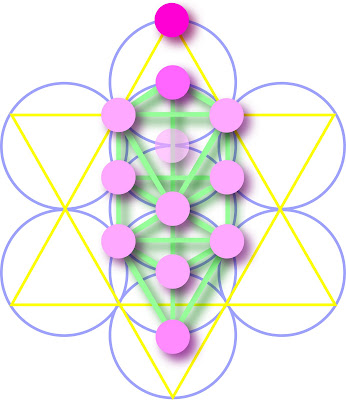
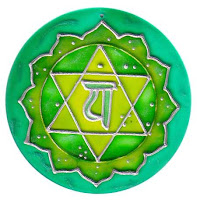

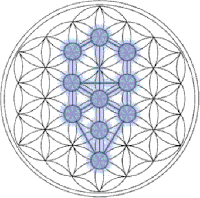

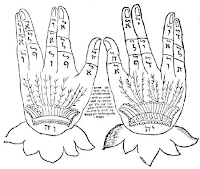

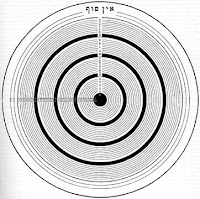
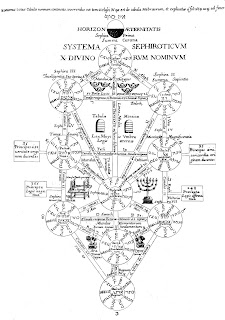
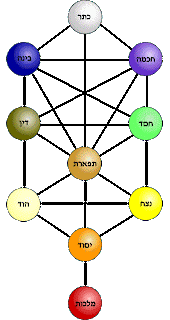
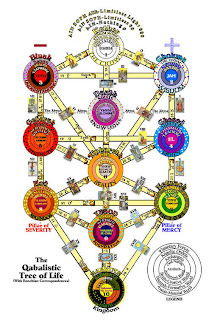


0 Comments:
Post a Comment
Subscribe to Post Comments [Atom]
<< Home